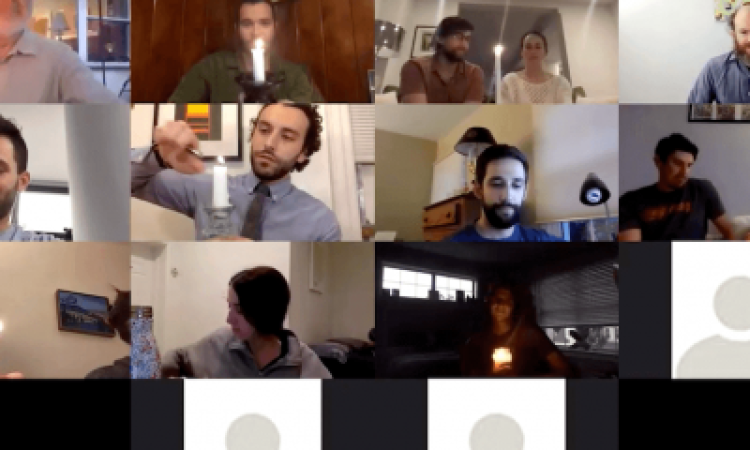A small, somber crowd gathers outside the Old City Jewish Arts Center like mourners outside a funeral home for Time, Collapsed, the live portion of A Golem Sleeps and Wakes in the Mourning. This interactive exhibit features filmed performances and multimedia art objects from “the theatre of grief,” a series of four theatrical works created by Benjamin Behrend and Logan Gabrielle Schulman since the 2018 Tree of Life Synagogue shooting in Pittsburgh.
Educator, director, and performance artist Schulman totes a water-filled bucket, and asks each person if they would like to participate in a ritual hand washing. This act re-creates the Judaic tradition of washing one’s hands after leaving a cemetery; rabbinic sources explain this is to banish evil spirits. I hold out my hands along with others in the audience, but the ritual seems more staged than sincere.
Soon, a golem, portrayed by Benjamin Bass, takes the sidewalk. In Jewish lore, a golem is a clay creature that has been magically brought to life. The Hebrew word “golem,” which means something incomplete or unfinished, is appropriate for this work that honors those whose lives were cut short by gun violence. Wearing all black, a blue mask and a screen of black lace, the golem moves in slow, seemingly tortured motion, as if embodying grief. In this piece, the golem is a creature who shepherds lost souls. The golem’s mask has what I consider a stereotypically big nose, and I am momentarily offended, but I realize this may be intentional to reveal the undercurrent of anti-Semitism in our society. I scan the faces of the crowd during this first act that represents the shiva, or seven days of intense mourning following a Jewish burial. Most of the viewers are transfixed, and a few suppress smiles. I wonder if they are as uncomfortable as I am. And that’s the point: grief is uncomfortable, and we all process it differently.
The second act, which represents shloshim, the 30-day secondary mourning period after a burial, takes place inside the gallery. In one corner of the gallery, a TV shows clips from Welcome to the Shiva House, originally performed in September 2020 via Zoom as part of Philly’s Fringe Festival. In Act Two, our golem drapes a white sheet on the floor, which then begins to inflate. But we can see it’s simply an air mattress. I don’t think this adds any value to the piece; it reminds me of the disappointment in discovering the secret to a magic trick. The golem scatters dirt on the sheet, just as family members shovel dirt onto the casket before it is lowered into the ground in a Jewish funeral. Then the golem places three heavy rocks on top of the sheet, mimicking the Jewish ritual of placing stones on a headstone, but the deeper meaning escapes me; I am too distracted worrying that the air mattress will burst.
Audience members reach into a box that is passed around, one by one drawing a slip of paper, as if pulling from a tragic misfortune cookie. Each reads aloud from their slip the name and age of a child under 12 killed by gun violence in the past year. An unraveled scroll reminiscent of a megillah bears the names of 80-plus victims.
Behrend closes out Act Three, symbolizing the Jewish ritual of yahrzeit, by lighting a candle. A yahrzeit marks the one-year anniversary of the death of a family member or loved one, and a candle is lit in their memory.
While the show is focused on fantasy, the talk-back afterward is rooted in reality and even more powerful to me. It is facilitated by Aleida Garcia, a Philadelphia community leader, victim advocate, and the founder of the National Homicide Justice Alliance. She is joined by activist/speaker Roz Pichardo, a survivor of violence. Textile artist Kathryn Pannepacker, creator of The Healing Blanket Project, gives everyone a piece of yarn to tie around their neighbor’s wrist and recite a prayer of comfort.
Schulman, borrowing a Quaker tradition, asks us to sit quietly and reflect. My mind races from George Floyd (Derek Chauvin’s sentencing was announced just a couple hours earlier), to the condo collapse just a day before in Florida, Columbine, Sandy Hook, to those who lacked closure for loved ones lost during COVID, to the Parkland massacre and my family’s participation in the March for Our Lives rally in Washington, DC. I cannot process it all. Gradually, people begin to share their personal stories of loss and grief with the group. As a parting gift, we each are given a card with the photo, name, and age of someone lost to gun violence. Mine reads: Terry Singletary, 24. His murder case remains unsolved. We also received a list of resources on gun control and combating violence, including information on upcoming community events sponsored by Philly Unknown and Operation Save Our City.
I was emotionally drained afterward, but grateful that these artists provided a safe space for collective mourning, for remembrance, and for reflection.
Time Collapsed, A Golem Sleeps and Wakes in the Mourning, Old City Jewish Arts Center, June 4 – July 2, 2021 (admission is free). Live gallery performances July 2 at 5:30 and 7 p.m., with artist talk at 6 p.m.






